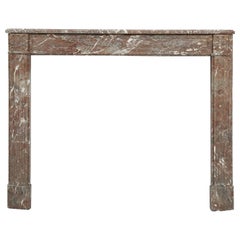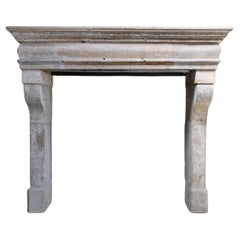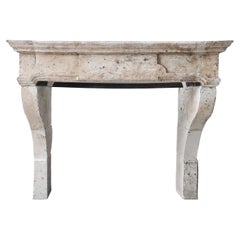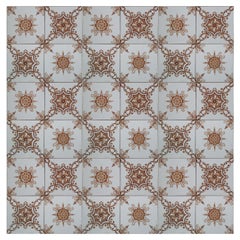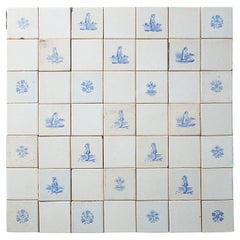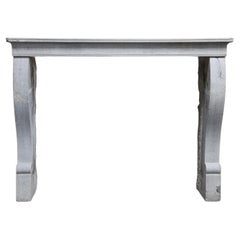Europe - Architectural Elements
to
381
1,996
1,626
1,825
156
15
Height
to
Width
to
165
117
114
102
97
83
62
61
57
52
40
35
23
20
10
7
4
2
530
790
505
171
158
144
131
14
3
51
25
4
25
35
53
5
5
917
558
492
392
209
1,814
622
398
381
319
1,996
1,875
1,940
59
33
20
15
11
Item Ships From: Europe
Parisian Louis XVI Fireplace Mantel
Located in Haarlem, Noord-Holland
Delightful French Louis XVI "Demi Lune" style fireplace mantel.
This Parisian Louis XVI fireplace mantel is the perfect mix of simple and strong profiled elements.
Executed in a lo...
Category
19th Century French Louis XVI Antique Europe - Architectural Elements
Materials
Marble
Antique castle fireplace in style of Campagnarde from the 19th century
Located in Made, NL
This 19th century French Campagnarde style fireplace is made from authentic limestone. The robust design and soft weathering give a warm, rural look. A timeless and characterful piec...
Category
19th Century French Other Antique Europe - Architectural Elements
Materials
Limestone
Antique Castle Fireplace of french limestone from the 18th century Louis XIII
Located in Made, NL
Very beautiful and robust castle mantelpiece made of French limestone! This antique mantelpiece dates from the 18th century and has a subtle ornament in the middle of the front part ...
Category
18th Century French Other Antique Europe - Architectural Elements
Materials
Limestone
1 of the 36 Unique Antique Tiles, Societe Morialme circa 1920, Belgium
By Societe Morialme
Located in Rijssen, NL
A large set of unique antique tiles, red brown colored with a beautiful Art Deco pattern, Societe Morialme circa 1920, Belgium
The dimensions per tile are 5.9" (15 cm) x 5.9" (15 cm).
Please note that the piece is for 1 piece! more pieces available. Also border tiles...
Category
1920s Belgian Art Deco Vintage Europe - Architectural Elements
Materials
Ceramic
Reclaimed Bratt Colbran Ceramic Tiles
Located in Wormelow, Herefordshire
An unusual set of 49 Delft style tiles manufactured by renowned English fireplace makers Bratt Colbran of London.
Dating from circa 1920, these reclaimed 3 inch fireplace tiles showcase a smooth white colour detailed with various blue scenes of figures and floral designs incorporating Victorian and Georgian styles.
The perfect set to be used as a decorative panel or a impressive splash back...
Category
Early 20th Century English Georgian Europe - Architectural Elements
Materials
Clay
Antique fireplace of french limestone in style of Campagnarde, 19th century
By Rustic Design
Located in Made, NL
Very nice rustic mantelpiece of gray marble stone. A mantelpiece with few ornaments, but with beautiful lines and slightly curved legs. This mantelpiece in Campagnarde style is from ...
Category
19th Century French Other Antique Europe - Architectural Elements
Materials
Limestone
Large Art Deco Push Pull Door Handles in Brass
Located in London, GB
A set of two large lateral push-pull door handles of tubular brass. English, art deco style, 20th century.
A striking set - each piece made to span the full width of a door - the h...
Category
20th Century German Mid-Century Modern Europe - Architectural Elements
Materials
Bronze
$2,677 / set
Antique Marble Fireplace Arabescato Marble 19th Century Monumental
Located in Made, NL
Exceptional, impressive and monumental 19th century antique fireplace surround in beautiful Arabescato marble.
The carving is in superb quality showing the high standard and exceptional craftsmanship of its sculpturer. This unique antique chimneypiece mantle is a one in its kind
The style of this antique mantle...
Category
19th Century French Louis XV Antique Europe - Architectural Elements
Materials
Marble
French Style Wrought Iron Greenhouse with Door and Windows in White Color
Located in Marbella, ES
French style wrought iron greenhouse with doors and windows that open outwards. Ready for glass panels to be installed.
Category
2010s French Europe - Architectural Elements
Materials
Iron
Wrought iron balustrade
Located in COULLONS, FR
Wrought iron balustrade
- price is per unit
- Width excluding fixings is 98.5cm
- One piece weighs approximately 9Kg
Category
Late 19th Century French Antique Europe - Architectural Elements
Materials
Wrought Iron
$275 / item
1 of the 275 Art Deco Glazed Relief Tiles by Gilliot, circa 1920 (Copy)
By Gilliot
Located in Rijssen, NL
1 of the 275 handmade antique tiles in rich yellow and green glazed colors. Manufactured around 1920 by Gilliot Hemiksem, Belgium. These tiles would be charming displayed on easels, ...
Category
Early 20th Century Belgian Art Deco Europe - Architectural Elements
Materials
Ceramic
1 of the 30 Art Deco Glazed Relief Tiles by Gilliot, Hemiksem, circa 1920
By Gilliot
Located in Rijssen, NL
1 of the 30 handmade antique tiles in rich brown and green glazed colors. Manufactured around 1920 by Gilliot Hemiksem, Belgium. One tile is divided in four squares, two brown and tw...
Category
Early 20th Century Belgian Art Deco Europe - Architectural Elements
Materials
Ceramic
19th Century, French Zinc Mythical Lion- Wolf Head Fragment
Located in Buisson, FR
Beautiful and rare decorative zinc item that once graced a facade, France, circa 1850-1900
Weathered but despite of its age in a good condition
Measurement here below is inclusive th...
Category
19th Century French Antique Europe - Architectural Elements
Materials
Zinc
$329 Sale Price
44% Off
Salvador Dali “La Suite Catalane” Set of 6 Dali Tiles, 1954
Located in Berlin, DE
“La Suite Catalane”
Complete set of 6 painted and glazed ceramic tiles after paintings by the artist
Spain, 1954. Stamped 1954 verso
Salvador Dali...
Category
1950s Vintage Europe - Architectural Elements
Materials
Ceramic
$1,292 Sale Price / set
20% Off
Exquisite Classic French Antique Limestone Fireplace Surround
Located in Beervelde, BE
This fine Louis XVI antique fireplace surround in French limestone is in great condition.
Original and one of a kind mantle, a real work of art, with floral details on the front of ...
Category
Late 18th Century French Louis XVI Antique Europe - Architectural Elements
Materials
Limestone
Impressive Architectural Gilded Decorative Door Panel, Italy, Early 18th Century
Located in London, GB
Northern Italy, early 18th century
With feature generously proportioned gilded scrolls surmounted with an acanthus leaf crest motif. Would be stunning if re-appropriated as a full height mirror...
Category
Early 18th Century Italian Antique Europe - Architectural Elements
Materials
Gold Leaf
Antique French Fireplace
Located in Made, NL
Beautiful antique fireplace made of French limestone from the 19th century in the style of Louis XIII. This French antique fireplace mantle has a wide front section with beautiful o...
Category
19th Century French Louis XIII Antique Europe - Architectural Elements
Materials
Limestone
$13,085 Sale Price
20% Off
Architectural Push and Pull Bronze Door Handle Square with matching Bell
Located in London, GB
Pair of square bronze push and pull door handles and matching bell with central horizontal border of Brutalist relief creating a stunning detail to the door. They can be mounted on a...
Category
1970s European Mid-Century Modern Vintage Europe - Architectural Elements
Materials
Bronze
19th Century Stone Doorway Arch
Located in Vosselaar, BE
A 19th century stone door surround. Simply but elegant rustic executed. Dated 1819 and decoretad with a geometric frieze and centrel flower rozet. ...
Category
Early 19th Century French French Provincial Antique Europe - Architectural Elements
Materials
Sandstone
French Style Wrought Iron Greenhouse with Door and Windows in Green Color
Located in Marbella, ES
French style wrought iron greenhouse with doors and windows that open outwards in white color. Ready for glass panels to be instal...
Category
2010s French Europe - Architectural Elements
Materials
Iron
Rare Olympic games prefab Munich 1972 by Peter Hübner
By Another Human
Located in Perpignan, FR
CASANOVA. 1972
by Gallery Clément Cividino Ent.
HISTORIQUE
A l'occasion des jeux olympiques de Paris 2024 , notre galerie présente en exposition pour son rendez vous estival au domaine viticole Terra Remota une capsule habitable modulaire appelée Casanova. Ces capsules modulaires polyèdres ont une superficie de 9m2. De fabrication économique et légères, elles étaient utilisées temporairement pour des infrastructures d'accueil et logements temporaires. L’exemplaire que nous présentons servait à l’accueil des athlètes pour les jeux olympiques de Munich 1972.
Dessinée au début des années 70 par l’architecte Allemand Peter Hübner...
Category
1970s French Space Age Vintage Europe - Architectural Elements
Materials
Fiberglass, Polyester, Polystyrene
1 of the 20 Glazed Art Nouveau Relief Tiles, Maison Helman, Céramiques d'Art
By OTHR
Located in Rijssen, NL
1 of the 20 amazing original antique Art Nouveau handmade tiles manufactured in 1920s by Maison Helman - Céramiques d'Art - St. Agatha-Berchem.
A beautiful relief and deep green, ro...
Category
1920s Austrian Art Nouveau Vintage Europe - Architectural Elements
Materials
Ceramic
Radiator cover in bamboo and Vienna straw with leather bindings. Molto Editions
Located in Roma, RM
Radiator cover in bamboo and Vienna straw with leather bindings. Molto Editions
Italian artisanal production
Dimensions: 92L x 100H x 20D cm
Other size available please contact us if...
Category
2010s Italian Europe - Architectural Elements
Materials
Leather, Bamboo
Antique fireplace in style of Louis XVI, 19th century, carrara marble
Located in Made, NL
Beautiful antique fireplace from the 19th century in Louis XVI style, made of high-quality Carrara marble. This antique fireplace is straight in shape, characterized by its straight ...
Category
19th Century French Louis XVI Antique Europe - Architectural Elements
Materials
Marble, Carrara Marble
Exceptional Mid-Century Murano Glass Push & Pull Door Handles by Seguso 1950s
By Barovier&Toso, Seguso, Archimede Seguso, Venini
Located in Munich, DE
Extremely rare and elegant Mid-Century Modern double push & pull door handles in Murano glass with gold layer. Real vintage gems. Probably designed by Archimede Seguso for Seguso Vet...
Category
1950s Italian Mid-Century Modern Vintage Europe - Architectural Elements
Materials
Brass
Pair of Arts & Crafts Door Knobs
Located in London, GB
A pair of Arts & Crafts brass door knobs with shield shaped back plates.
Supplied with square bar to fit locks.
Projection from door: 2 inches - 5 cm.
Category
Late 19th Century English Arts and Crafts Antique Europe - Architectural Elements
Materials
Brass
$362 Sale Price
20% Off
French, 19th Century, Zinc Bacchus Head Ornament
Located in Buisson, FR
Very rare zinc Bacchus head that once graced a Parisian facade,
Original period piece, France, circa 1850-1900.
Weathered.
Category
19th Century French Antique Europe - Architectural Elements
Materials
Zinc
$448 Sale Price
52% Off
Antique & Monumental, Finest Bronze American Bald Eagle Sculpture Door Knocker
Located in Lisse, NL
Certainly the most impressive antique door knocker on 1stdibs.
This marvelously finest handcrafted and amazing condition antique door knocker is another one of our recent great finds. Can you imagine this fine bronze eagle head on your door? Having this gorgeous bronze door knocker made as the finishing touch, would have made this a real statement piece, and it still will be. Mind you, with a unique and all hand-crafted bronze door knocker of this size, quality and beauty suddenly in your face and you too would be impressed when showing up at this front door. Especially with the fierce looking eagle holding the wreath knocker in his beak staring at you. They really don't make 'em like this anymore and we are proud to be able to offer it to the 1stdibs community in such amazing condition.
Mind you, our price for this unique antique bronze door knocker...
Category
Late 19th Century French Arts and Crafts Antique Europe - Architectural Elements
Materials
Bronze
Huge amazing richly carved wooden portal frame, Italy
Located in Cuneo, Italy (CN)
Incredible and enormous portal in poplar wood richly carved with leaf decorations and volutes, ancient and original from the 18th century, sumptuous and luxurious. A rare historical ...
Category
18th Century Italian Antique Europe - Architectural Elements
Materials
Poplar
$19,172 Sale Price
20% Off
Antique Breccia Marble Floor Tiles 5.95 m2 (64 ft2)
Located in Wormelow, Herefordshire
These late 19th century reclaimed Italian floor tiles in Breccia marble were salvaged from Wingfield castle in England.
Dating from circa 1880, th...
Category
Early 19th Century Italian Regency Antique Europe - Architectural Elements
Materials
Clay
Antique Square Louis XVI Fireback
Located in Haarlem, Noord-Holland
Great square antique cast iron fireback showing a female drinking.
Excellent condition, great dimension.
Can be used in a fireplace or as backsplash.
Category
19th Century European Louis XVI Antique Europe - Architectural Elements
Materials
Iron
$384 Sale Price
20% Off
jean Prouvé kitchen extractor 1972
By Jean Prouvé
Located in Perpignan, FR
Hotte de cuisine réalisé par jean Prouvé pour l'ameublement du refuge du Col de La Vanoise en 1972.
Démontée par nos soins sur place lors du démontage des bâtiments .
Bon état géné...
Category
1970s French Mid-Century Modern Vintage Europe - Architectural Elements
Materials
Metal
1 of the 150 Antique Dark Red/Brown Ceramic Tiles by Morialme, circa 1930s
By Societe Morialme
Located in Rijssen, NL
Recently lifted from its original home, a set of antique tiles from the early 20th century. With a beautiful geometric stylized design.
Manufactur...
Category
1930s European Art Deco Vintage Europe - Architectural Elements
Materials
Ceramic
Pair 19th Century, French Zinc Mythical Lion- Wolf Head Fragments
Located in Buisson, FR
Beautiful and rare decorative zinc item that once graced a facade, France, circa 1850-1900
Weathered and small losses but despite of its age in a good condition
Measurement here belo...
Category
19th Century French Antique Europe - Architectural Elements
Materials
Zinc
$688 Sale Price / set
41% Off
18th Century 'circa 1750' George II Pine Doorway
Located in London, GB
An 18th century (circa 1750) George II pine doorway. The barrel frieze carved with shell centre and scrolled leaves and foliage, surmounted by egg and dart dentil cornice. Panelled p...
Category
18th Century English George II Antique Europe - Architectural Elements
Materials
Pine
Four Cast Iron Consoles/Radiator Covers from The Royal Liverpool School of Music
Located in London, GB
Four Arts and Crafts cast iron radiator covers or console tables were made by The Liverpool and Macclesfield Cast Iron Co in the 1860s.
Pleas...
Category
Late 19th Century English Arts and Crafts Antique Europe - Architectural Elements
Materials
Iron
Pair of Wrought Iron Screens with Floral Patterns, early 20th Century, European
Located in London, GB
A set of two very attractive wrought iron screens depicting flowers and stylised leaves. European, early years of the twentieth century, possibly German or Czech in art nouveau or ea...
Category
Early 20th Century German Art Nouveau Europe - Architectural Elements
Materials
Wrought Iron
Cast Iron Lion and Unicorn
Located in Leamington Spa, Warwickshire
19th C cast iron lion and unicorn with original paint. 1860.
Unicorn dimensions: 26" W x 4" D x 18" H.
Lion dimensions: 27" W x 5" D x 14" H.
...
Category
19th Century English Victorian Antique Europe - Architectural Elements
Materials
Iron
$2,210 / set
Small French Louis XV Fireplace Mantel
Located in Haarlem, Noord-Holland
Small French Louis XV Fireplace Mantel.
Unique little Louis XV Fireplace mantel in Corton Violine limestone from the area of Burgundy in France. The soft and warm tones makes this...
Category
Late 18th Century French Louis XV Antique Europe - Architectural Elements
Materials
Limestone
Queen Lavanette steel kitchen vanitie
Located in Mortsel, BE
Queen Lavanette “Vanette” steel bathroom kitchen vanities
Category
Mid-20th Century Mid-Century Modern Europe - Architectural Elements
Materials
Metal, Steel
Antique Mantel
Located in Made, NL
Antique Paonazzo Marble Chimneypiece for Sale
There is something undeniably captivating about an original antique fireplace mantel, especially one crafted from a rare and beautif...
Category
19th Century French Louis XIV Antique Europe - Architectural Elements
Materials
Marble
$20,942
Large Clear Glass Door Handles Pair, Round Push & Pull
Located in London, GB
Pairs of round double door 1960's push and pull handles in clear glass with subtile wave relief, cast glass (2cm thick) with aluminum fittings. They are designed for a glass doors bu...
Category
1960s French Mid-Century Modern Vintage Europe - Architectural Elements
Materials
Aluminum
Antique Elephant Doorstop, English, Great Exhibition, Door Keeper, Victorian
Located in Hele, Devon, GB
This is a delightful antique elephant doorstop. An English, handpainted cast iron decorative door keeper or mantel ornament, dating to the early Victorian period, circa 1850. A fine ...
Category
1850s British Early Victorian Antique Europe - Architectural Elements
Materials
Iron
Floral Art Deco Glazed Relief Tiles by Gilliot, Hemiksem, circa 1920
By Gilliot
Located in Rijssen, NL
1 of the 60 handmade tiles in rich purple and lightblue glazed colors with beautiful circular floral design. Manufactured around 1920 by Gilliot Hemiksem, Belgium. One tile set is d...
Category
1920s Belgian Art Deco Vintage Europe - Architectural Elements
Materials
Ceramic
17th/18th Century French Carved Wooden Lion Head
Located in Buisson, FR
Gorgeous hand-carved wooden lion head with a great patina due to its extreme high age.
France circa 1650-1750
Weathered. measurements include the wooden base.
H:31cm W:17cm D:12cm
Category
17th Century French Rustic Antique Europe - Architectural Elements
Materials
Wood
$593 Sale Price
50% Off
1 BANGA space age micro architecture prefab house bungalow by Carlo Zappa, 1971
By Carlo Zappa
Located in Frankfurt am Main, DE
here we offer one of 2 bangas, with light grey interior. the second one with black interior is offered in another listing.
a banga shows ways in which we could live more sustainably, resource-efficiently and minimally – whether in the city on previously empty roofs or in the countryside to make better use of large plots of land. whether as a guest room in the garden or as a vacation home at the lake: a banga usually doesn’t need a building permit, because its floor area remains under 10m² (but beware: in nature reserves or conservation areas other rules may apply, of course!) and as a design object in a very small edition, the banga – in contrast to the diy store hut – rather doesn’t suffer from loss of value.
- design & development: carlo zappa, milan
- trademark / patent: no. 23306 b/71 and no. 30719 a/71
- construction period: first series 1971 to 1974
- last distribution: bungalows international srl, milan
- complete restoration: 2022
- external dimensions : wxlxh 3,24m x 3,24m x 2,80m
- floor space: 8,1m²
- weight: approx. 850 kg
- walls: 2-layers of 2,5mm fiber sprayed grp sheets
- floor: osb wood-based panel on wooden beams on stainless steel profiles
- insulation: 20mm rock wool/ pur insulation
- windows: 4 x round sliding glass + grp sliding shutters
- doors: double walled glass fiber reinforced polyester resin (2 mms each)
- edgings: partly aluminum / stainless steel piping
- interior: grp, spray paint high gloss white ral 9016
- restauration: documentation available
facilities:
living room-bedroom
- 2 sofas that can be converted into 4 beds
- 4 new cushions / mattresses (covered in a light grey or black fabric)
- many niches, shelves and cupboards
- 2 integrated architectural lights made of translucent grp
- ‘norament’ 926 rubber studded floor (black)
- induction floor heating
- ‘redwell’ infrared radiant heating (power 400w)
- natural ventilation system, manually adjustable with wooden sliders
- and of course a banga pillow and 2 sleeping masks are included
kitchenette
- sink with ‘hansanova style’ standing faucet and ‘grohe therm cosmopolitan’ two-handle grips
- flow-type calorifier (up to 60℃ / 140℉) for sink, shower and washbasin
- 1 double socket under the sink
bathroom
- completely separated from the living room
- sink, shower, toilet, even the waste pipe is made of grp
- slip shower head for sink and shower
- ‘uten_silo’ wall container...
Category
1970s Italian Space Age Vintage Europe - Architectural Elements
Materials
Fiberglass
1 BANGA space age micro architecture prefab house bungalow by Carlo Zappa, 1971
By Carlo Zappa
Located in Frankfurt am Main, DE
here we offer one of 2 bangas, with black interior. the second one with light grey interior is offered in another listing.
a banga shows ways in which we could live more sustainably, resource-efficiently and minimally – whether in the city on previously empty roofs or in the countryside to make better use of large plots of land. whether as a guest room in the garden or as a vacation home at the lake: a banga usually doesn’t need a building permit, because its floor area remains under 10m² (but beware: in nature reserves or conservation areas other rules may apply, of course!) and as a design object in a very small edition, the banga – in contrast to the diy store hut – rather doesn’t suffer from loss of value.
- design & development: carlo zappa, milan
- trademark / patent: no. 23306 b/71 and no. 30719 a/71
- construction period: first series 1971 to 1974
- last distribution: bungalows international srl, milan
- complete restoration: 2022
- external dimensions : wxlxh 3,24m x 3,24m x 2,80m
- floor space: 8,1m²
- weight: approx. 850 kg
- walls: 2-layers of 2,5mm fiber sprayed grp sheets
- floor: osb wood-based panel on wooden beams on stainless steel profiles
- insulation: 20mm rock wool/ pur insulation
- windows: 4 x round sliding glass + grp sliding shutters
- doors: double walled glass fiber reinforced polyester resin (2 mms each)
- edgings: partly aluminum / stainless steel piping
- interior: grp, spray paint high gloss white ral 9016
- restauration: documentation available
facilities:
living room-bedroom
- 2 sofas that can be converted into 4 beds
- 4 new cushions / mattresses (covered in a light grey or black fabric)
- many niches, shelves and cupboards
- 2 integrated architectural lights made of translucent grp
- ‘norament’ 926 rubber studded floor (black)
- induction floor heating
- ‘redwell’ infrared radiant heating (power 400w)
- natural ventilation system, manually adjustable with wooden sliders
- and of course a banga pillow and 2 sleeping masks are included
kitchenette
- sink with ‘hansanova style’ standing faucet and ‘grohe therm cosmopolitan’ two-handle grips
- flow-type calorifier (up to 60℃ / 140℉) for sink, shower and washbasin
- 1 double socket under the sink
bathroom
- completely separated from the living room
- sink, shower, toilet, even the waste pipe is made of grp
- slip shower head for sink and shower
- ‘uten_silo’ wall container...
Category
1970s Italian Space Age Vintage Europe - Architectural Elements
Materials
Fiberglass
18th Century Grecian Marble Wall Relief
Located in Gloucestershire, GB
An 18th Century Grecian Wall relief from an Ionian church.
This would have sat embedded in the wall on the outside of the church, beautifully salt weathered from years of exposure w...
Category
18th Century Antique Europe - Architectural Elements
Materials
Marble
Antique Walnut Entrance Main Door Complete with Portal, 18th Century, Italy
Located in Cuneo, Italy (CN)
Ancient entrance door, main door, built and hand-carved in precious walnut wood, original and complete with portal, made in the 18th century, for an important building in the histori...
Category
18th Century Italian Antique Europe - Architectural Elements
Materials
Walnut
$14,360 Sale Price
20% Off
Pair of Gothic Columns - Italy, 14th-15th century
Located in Bruxelles, BE
Rare pair of Gothic Columns - Olivetani
Marble
Italy, 14th - 15th century
Heraldic shields on the capitals of the Order of the Olivetani
H 220 et 225 cm x W 25 x D 25 cm
H 86 2/3 & 8...
Category
15th Century and Earlier Italian Gothic Antique Europe - Architectural Elements
Materials
Marble
$77,785 / set
HUGE Pair of 13-Light Handforged Wrought Iron Castle Chandeliers w. Gothic Crown
Located in Lisse, NL
Largest ever pair of Medieval Style chandeliers, over 5 feet tall.
With 20th century lighting as one of our specialities we have seen and sold all kinds of light fixtures, but never...
Category
20th Century European Medieval Europe - Architectural Elements
Materials
Wrought Iron, Metal
19th Century Italian Hand Carved Giltwood Baroque Style Curl Ornament
Located in Buisson, FR
Beautiful handcarved giltwood baroque style ornament that once adorned a chapel or a church.
Italy, circa 1850. Weathered and small losses. Measurement includes the wooden base.
H:31...
Category
19th Century Italian Baroque Antique Europe - Architectural Elements
Materials
Wood
$353 Sale Price
48% Off
Red Glass Door Handle Pair for Push & Pull Double
Located in London, GB
A pair of double door handles, push and pull, square textured vibrant red cast glass with mat antique bronze anodised aluminium. They are designed for a glass or wooden doors but sui...
Category
1960s German Mid-Century Modern Vintage Europe - Architectural Elements
Materials
Metal, Aluminum
Imposing Pair of Carved Satin Wood Doors
Located in London, GB
A pair of monumental solid satinwood doors with classical egg and dart carved decoration and fine quality brass door furniture.
Brass door pulls marked CHING (Comyn Ching of Londo...
Category
Late 19th Century English Antique Europe - Architectural Elements
Materials
Satinwood
19th Century Fireplace in Style of Louis XVI of Blue Fleuri Marble
Located in Made, NL
A beautiful 19th century Blue Fleuri marble fireplace in the style of Louis XVI. A straight model with many fluting in the front part and continuous on the legs! The dimensions are a...
Category
19th Century French Louis XVI Antique Europe - Architectural Elements
Materials
Marble
$10,313 Sale Price
20% Off
Architectural Panel
Located in London, England
Decorative two part panel of stylised panel in brick. Circa 1890
H 52cm x W 95cm x D 17cm
Category
1880s Antique Europe - Architectural Elements
Materials
Terracotta
$2,192
Jean Prouve Facade element in enamal France 1965
By Jean Prouvé
Located in Roosendaal, Noord Brabant
Rare facade element by Jean Prouve, designed for the André-Argouges high school, Grenoble France 1965. Made of enamelled metal with isolation inside. A...
Category
1960s French Mid-Century Modern Vintage Europe - Architectural Elements
Materials
Enamel
20th Century Art Nouveau Style Iron Spiral Staircase
Located in Vulpellac, Girona
20th Century Art Nouveau style spiral staircase from Spain in good condition and easy to assemble.
This stair belonged to an old Factory in Spain, that closed at the end of the 2...
Category
Early 20th Century Spanish Art Nouveau Europe - Architectural Elements
Materials
Iron
$10,530 Sale Price / item
20% Off
18th Century 'circa 1720' George II Pine Doorway
Located in London, GB
18th century (circa 1720) George II pine doorway, carved by John Cuenot for Norfolk House St James' London.
Width at Top 58"/1485 mm
Overall Height 110"/2794 mm
Opening Height 85...
Category
18th Century English George II Antique Europe - Architectural Elements
Materials
Pine
18th Century Spanish Corinthian Hand-Carved Carble Capital
Located in Marbella, ES
18th Century Spanish Corinthian hand-carved carble capital.
Category
18th Century Spanish Antique Europe - Architectural Elements
Materials
Marble
Recently Viewed
View AllMore Ways To Browse
Carved Wood Archway
Cast Stone Plaque
Church Railings
Corrugated Glass Panels
French Iron Fence
French Iron Grill
French Roof Finial
Iron Hanging Pot Rack
Large Architectural Frieze
Liberty Stained Glass
Outdoor Torchiere
Overdoor Gilt
Roof Spire
Sherle Wagner Drawer Pulls
Sicis Mosaic Tile
Stone Carved Crest
Tall Garden Finial
Terracotta Ornaments
